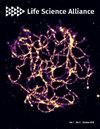VDR restores the expression of PINK1 and BNIP3 in TECs of streptozotocin-induced diabetic mice.
IF 3.3
2区 生物学
Q1 BIOLOGY
引用次数: 0
Abstract
Defective mitophagy in renal tubular epithelial cells is one of the main drivers of renal fibrosis in diabetic kidney disease. Our gene sequencing data showed the expression of PINK1 and BNIP3, two key molecules of mitophagy, was decreased in renal tissues of VDR-knockout mice. Herein, streptozotocin (STZ) was used to induce renal interstitial fibrosis in mice. VDR deficiency exacerbated STZ-induced renal impairment and defective mitophagy. Paricalcitol (pari, a VDR agonist) and the tubular epithelial cell-specific overexpression of VDR restored the expression of PINK1 and BNIP3 in the renal cortex and attenuated STZ-induced kidney fibrosis and mitochondrial dysfunction. In HK-2 cells under high glucose conditions, an increased level of α-SMA, COL1, and FN and a decreased expression of PINK1 and BNIP3 with severe mitochondrial damage were observed, and these alterations could be largely reversed by pari treatment. ChIP-qPCR and luciferase reporter assays showed VDR could positively regulate the transcription of Pink1 and Bnip3 genes. These findings reveal that VDR could restore mitophagy defects and attenuate STZ-induced fibrosis in diabetic mice through regulation of PINK1 and BNIP3.VDR 可恢复链脲佐菌素诱导的糖尿病小鼠 TEC 中 PINK1 和 BNIP3 的表达。
肾小管上皮细胞有丝分裂缺陷是糖尿病肾病肾纤维化的主要驱动因素之一。我们的基因测序数据显示,VDR基因敲除小鼠肾组织中有丝分裂的两个关键分子PINK1和BNIP3的表达量减少。在此,我们使用链脲佐菌素(STZ)诱导小鼠肾间质纤维化。VDR 缺乏会加剧 STZ 诱导的肾功能损伤和有丝分裂缺陷。帕立骨化醇(pari,一种VDR激动剂)和肾小管上皮细胞特异性过表达VDR可恢复肾皮质中PINK1和BNIP3的表达,减轻STZ诱导的肾脏纤维化和线粒体功能障碍。在高糖条件下的 HK-2 细胞中,观察到 α-SMA、COL1 和 FN 水平升高,PINK1 和 BNIP3 表达降低,线粒体损伤严重,这些变化在很大程度上可通过帕利治疗逆转。ChIP-qPCR 和荧光素酶报告实验表明,VDR 能正向调节 Pink1 和 Bnip3 基因的转录。这些发现揭示了VDR可通过调控PINK1和BNIP3恢复糖尿病小鼠有丝分裂缺陷并减轻STZ诱导的纤维化。
本文章由计算机程序翻译,如有差异,请以英文原文为准。
求助全文
约1分钟内获得全文
求助全文
来源期刊

Life Science Alliance
Agricultural and Biological Sciences-Plant Science
CiteScore
5.80
自引率
2.30%
发文量
241
审稿时长
10 weeks
期刊介绍:
Life Science Alliance is a global, open-access, editorially independent, and peer-reviewed journal launched by an alliance of EMBO Press, Rockefeller University Press, and Cold Spring Harbor Laboratory Press. Life Science Alliance is committed to rapid, fair, and transparent publication of valuable research from across all areas in the life sciences.
 求助内容:
求助内容: 应助结果提醒方式:
应助结果提醒方式:


